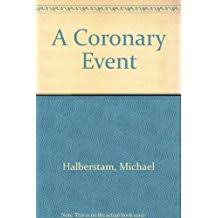In my gym, I meet the best people, and have the most interesting conversations, in the jacuzzi. It’s located in a corner of the large pool area and surrounded by a huge bay window extension. The sun is abundant, the water seems tropical, and, if I would drink, I would only ask for little drinks with tiny umbrellas. Sounds so California, and only the cardinals on the feeder outside the window remind me of being in the South. I met Carl during one of these solitary moments when you close your eyes and don’t let the other people into your world. He was a little older, grayer and had a body of a long-distance runner. Carl started the conversation, so I knew I wasn’t intruding.
He is a doctor, a psychiatrist, and a writer, too. His area of expertise was “medical quackery” and he served often as an expert witness in trials against dishonest medical professionals.
Carl invited me to his home, where I met his wife and saw his writing quarters. Simple, cluttered and inventive. At the end of my visit, he gave me a book to read. “A Coronary Event” by Halberstam and Lesher. Carl had a coronary bypass surgery in a distant past and the title was, I thought, also a bow to my professional past.
It didn’t take me long to start reading it, and, since I began, I couldn’t stop.
The story is about one of the authors, Lesher, having a heart attack and the other, Halberstam, treating him. Lesher is a journalist and Halberstam was a cardiologist. Lesher is still working, whereas Halberstam died in a horrific accident. They structured the book in a peculiar manner, with the patient and his doctor alternating the short chapters. It gives a unique way of seeing all, sometimes dramatic, events, from two different points of view: the doctor’s and his patient’s. And one wonders, how they see the same events so diametrically different.
Lesher was the most difficult patient any doctor could imagine. With his triple-A personality, complicated personal life, his wife with his children and his current lover at his bedside, often at the same time, and his “I want it all, and I want it now” attitude, he presented an utmost challenge even to the most understanding and accommodating doctor Halberstam certainly was.
But was not the plot what got my attention.
The book came out in 1973––forty-five years ago. Suddenly, I had an acute glimpse of the then-contemporary way of treating coronary artery disease and a myocardial infarction in particular. At that time, I’ve just started my medical career and in a year or so, I’ve committed my life to cardiac surgery. Reading this book worked for me like the opening of a forty-five-year old-time capsule, like entering the tomb of Tutankhamen, with all the dangers attached. I saw myself participating in a care of patients in times when cardiology and cardiac surgery were born. It also reminded me how much progress had we made with the treatment during my lifetime.
And what strides we’ve made! Not only mortality and morbidity are down. The incidence of coronary artery disease is also falling. So what happened?
I am not writing a scientific article. I am giving an impression of a cardiac surgeon who spent his life taking care of patients with this particularly dreaded problem.
First, we’ve learned how to distinguish life-threatening cases from the banal problems. Then we learned of crucial minutes in dangerous situations and acquired proper diagnostic tools to identify them and sophisticated therapeutic tools to treat them. We know now that six weeks bed rest, mandatory before, is harmful and can be deadly in certain circumstances. We bring the patient to a cardiac cath and intervene within the first hours if indicated. We lyse more clots early and deploy more stents. We seldom rush the patient to the operating room from the cath lab. We monitor our patients more diligently when necessary, and we don’t when we decide that the monitoring is not warranted.
And we see not as many cases as before because we eat better, don’t smoke as much and exercise like crazy.
Going back to my gym, I don’t see as many scars on the chests of my fellows-in-workout, as I saw before. Then I recollect my teacher telling me back when that everybody had to die with a scar in the middle of his chest.
Moreover, while reading “A Coronary Event” it struck me, how impeccable were Halberstam’s bedside manners. His patient’s overactive personality was magnified by the sudden realization that he, yes, even he, might die. The doctor came under the constant verbal assault by his patient, who blamed everyone around for his problems. Lesher acted like an investigative reporter, which in fact he was. Halberstam lived under fire from his constant, often irrelevant questioning. Being under non-stop attack was getting harder and harder to take for the doctor, and the verbal and mental sparring was even getting to his personal life. To make things more difficult, Lesher’s obstinate questions about sex drove his doctor insane and showed how different their outlooks were on what’s normal in life. The conflict between these two personalities and their contrasting life values added to the drama of the book.
Today, it’s unthinkable that a doctor would spend so much time with his patient. Halberstam made himself available to his hyperactive patient during the working hours and even after hours, which his patient abused quite often. Now, face-to-face time has become a hot commodity, with the detriment to both. But it is a patient who loses the most.
Today, in my gym, I don’t see as many scars on the chests of my fellows-in-workout. I see, however, more scars after the back surgery. Which tells me that the neurosurgical department at Duke is working overtime.


